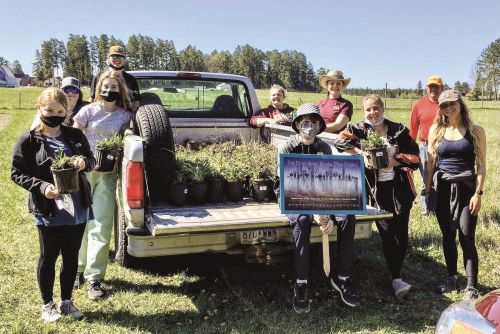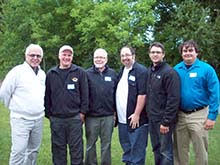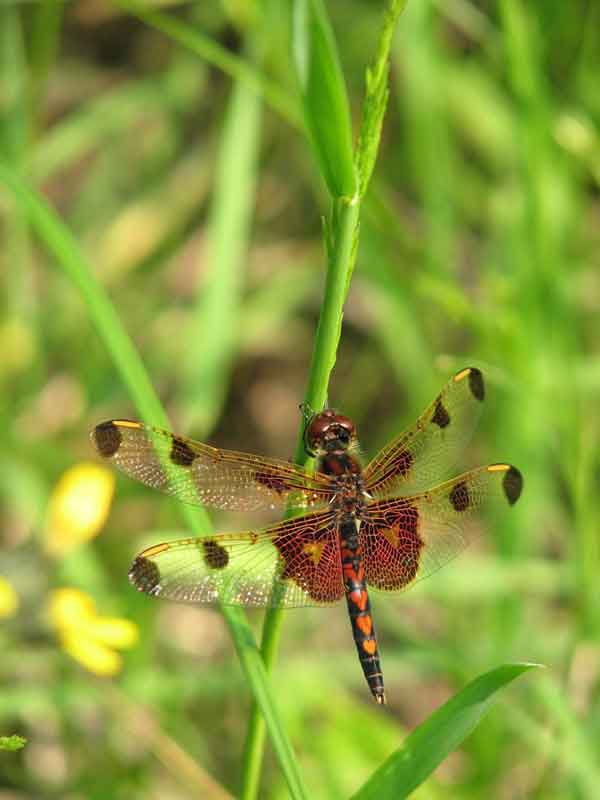
Protect Your Shoreline With An Itasca Waters Shoreland Advisor
Learn MoreCOMPLETED PROJECTS
Native Plant Planting (Summer 2021)
Through a partnership with Itasca Waters, the North Central Research and Outreach Center has been growing native plants, and 150 of these plants will be used in the planting at the Mississippi River Pedestrian Bridge by KAXE in Grand Rapids. The city is converting a 2500 square foot area into a space filled with native plants!
Any plant species that existed here before the arrival of European settlers is considered to be native to this area, and plant restoration experts typically try to source seeds or plants from within a 100-mile radius of a project site. Native plants do not include any cultivars or variants; they must come from the historical seed source to be authentic.
There are a lot of reasons to be excited about native plants. They are exceptionally hardy, meaning that they can withstand the weather extremes that Minnesota offers. They often have deep or dense root systems that help hold soil in place, decreasing erosion on steep slopes and hillsides. Native plants’ extensive root networks create pathways for rainwater and snowmelt to trickle down into the soil, decreasing the amount of stormwater runoff and pollution getting into our lakes and rivers. And those chickadees you love? Chickadees may eat sunflowers at your birdfeeders, but they depend on caterpillars to feed their babies in the spring. The butterflies and moths that those caterpillars come from lay their eggs on native plants – often targeting one or two plant species (think about Monarch butterflies’ dependence on milkweed …). If the moths can’t find the ‘right’ native plant species then there won’t be caterpillars for the chickadees to feed to their babies. This is nature’s delicate web of life.
The four species being used are all perennials that go dormant in the winter and begin to regrow every spring; they also spread by seed and/or below-ground rhizomes. These plants, which all attract and support pollinators, include:
- Fragrant giant hyssop (Agastache foeniculum). This plant is in the mint family so it has a square stem and a pleasant anise scent that is noticeable when the leaves are crushed. It reaches about 3’ in height and has a lavender flower spike at the top of the plant that blooms most of the summer. It grows best in dry, well-drained soil and full sun but is adaptable to a range of site conditions.
- Flat-topped aster (Doellingeria umbellata). Typical of plants in the aster family, this one blooms late-summer and fall. It has broad, flat clusters of white flowers with yellow/tan centers on top of stiff stems that are typically 2-3’ tall but can get much taller. Leaves are narrow and pointed on both ends. It does well in areas that are moist and at least partially sunny.
- Common ox-eye (Heliopsis helianthoides). Also known as oxeye sunflower or false sunflower, this plant in also in the aster family. It blooms throughout the summer with yellow flowers and yellowish/brown centers on stems 3-5’ in height. Individual flower petals are often notched at the tip. It grows best in sunny sites with well-drained soil but is tolerant of a range of conditions.
- Wild bergamot (Monarda fistulosa). Like the hyssop, this plant is a member of the mint family, and it has a pleasant minty or citrus-y scent. Its lavender flowers have been described as ‘ragged pompoms.’ It grows 2-4’ tall and blooms mid- to late summer. Commonly planted as a cultivar called beebalm, it thrives in a variety of conditions from dry to moist, sunny to partly shady.
In addition to the potted plants, a mixture of grass and flower seeds will be sown at the site. The mixture will include at least six grass species and 21 flower species, mimicking the diverse plant community that was here hundreds of years ago. So when the moths and butterflies show up, looking for a specific plant to lay their eggs on, they have a good chance of finding it.
Besides the work being done by the City of Grand Rapids, area ag and FFA students repotted the seedlings into larger containers earlier this spring, and an Itasca Waters Shoreland Volunteer, Jeff Poenix, designed the planting.
Installation of Used Fishing Line Receptacles (Spring 2021)

Youth Water Summit (ongoing)
The first Youth Water Summit for Itasca County 5th grade students was held on May 24, 2012. It started wet and it got wetter with temperatures in the high 50’s. Approximately 270 fifth grade students, 39 presenters, 23 volunteers, plus teachers and chaperones took part in the full-day, hands-on water-science activities. Itasca Waters (formerly Itasca Water Legacy Partnership) initiated the Water Summit with help from the partners listed below.
Rain did not hinder the first event, and one unique comment from a student on the post-event survey was “They must really feel water is important to do this in the rain!”. The first summit was a success and generated tremendous community support. Subsequent youth water summits were held every year through 2019 until Covid-19 cancelled the event in 2020. School Districts involved have been Grand Rapids, Bigfork, Greenway, St. Joe’s, and Deer River. By the year 2019, the number of students had increased from 270 to 425 and presenters from 39 to 53 (46 unique session choices in 2019). More...
We Are Water Minnesota Exhibit (2019)
Itasca Waters hosted the We Are Water MN interactive exhibit at the Reif during the summer of 2019. This educational exhibit, created by the Minnesota Humanities Center, explored the connections between the humanities and water. Visitors were able to reflect on local stories and the meaning and experiences of water in northern Minnesota. Other partners in this exhibit included these Minnesota agencies: Pollution Control Agency, the Minnesota Historical Society, Department of Health, Department of Agriculture, and the Department of Natural Resources.
Other local events included: the Lake Pokegama Nibi Walk; a Chamber luncheon featuring Paul Radomski, Minnesota’s lead scientific lake expert; and a Water Bar at Klockow Brewing.
Itasca Waters Aquatic Invasive Species Project (ongoing)
In 2013, Itasca Waters approached the Itasca County board to alert them to AIS issues in the county. We asked for money from the trust fund to initiate a preventative program. The first request was for money to institute a Comprehensive Invasive Species Management Area and to begin inspections and education on AIS at boat access ramps throughout the county.
The first request was turned down, but in 2013 the environmental trust fund allocated $20,000 for Itasca Waters to begin the program to educate the public. In 2014, the State allocated money to counties to provide awareness and inspections throughout Minnesota. Itasca County requested that Itasca Waters be the organization to raise AIS awareness and AIS knowledge within the county.
The demographics included access ramps, resort owners, bait shops, fishing guides, aviation businesses offering water landings, marine dealers, and riparian owners. Itasca Waters hired a project coordinator, and the AIS program began.
The program was governed by a technical committee from numerous agencies. We hired AIS inspectors the first year and found that on the 7 original lakes inspected (Bowstring, Deer, Pokegama, Splithand, Swan, Trout and Wabana) 29% of the boats inspected failed to follow state guidelines. In 2015 that percentage decreased to 9.5%, and has continued to drop in 2016 and 2017.
Each year the program has increased lake access inspections and has accomplished the goal of increasing awareness at all levels. Itasca Waters coordinated the program though 2016 and transferred the program to Itasca County Soil and Water at the beginning of 2017. At the end of 2016 nearly 20,000 inspections were conducted on many more than the original 7 lakes, numerous decontamination units were in operation, and summer jobs were provided to numerous people throughout the county. The program continues in 2018.
Itasca Community College (ICC) Water Testing Lab (completed 2015)
In 2015, operations of the ICC Water Testing Lab were transferred to RMB Environmental Laboratories, Inc.
When Itasca Waters received the first grant in 2007, the objective was to provide a state-certified water-testing laboratory that would provide local water testing capabilities and a practical educational experience for students at ICC who had an interest in water science. Under the direction of Drs. John Downing and Jack Jones, the ICC Lab obtained credible data from nearly 300 Itasca County lakes that had never been sampled. Due to lack of grant opportunities, ICC was unable to continue the operation of the laboratory and ICC, along with Itasca Waters, developed a plan to have a private laboratory take over the operations.
RMB Environmental Laboratories, Inc., Detroit Lakes, MN, owned and operated by Robert Borash, has agreed to operate the lab and to allow the continued education of ICC students in water sample collection and analysis. RMB has a long history of working with students and Robert Borash and his staff will fulfill Itasca Waters’ goal of maintaining a water quality lab in conjunction with student participation. RMB has the ability to analyze water samples from a variety of sources, including well water. Local lake associations and private residents are encouraged to contact RMB for more information regarding any water testing that they might need.
Purple Loosestrife Control (completed 2014)
In 2015, this project was transferred to Itasca Soil & Water Conservation District. Purple loosestrife control was begun in 2007 by the Turtle Lake Association before being turned over to Itasca Waters in 2011. Itasca Waters was the fiscal agent for this project for the years 2011 through 2014.
Economic Assessment of the Value of Lakes and Lake Water Quality in Itasca County, Minnesota (Completed 2014)
The general objective of this study was to estimate the recreational value of the County’s lakes and how these values change due to changes in water quality. Not surprisingly, Itasca County residents place a high value on water quality in local lakes. A study by Dr. Daniel Phaneuf, funded through a Blandin Foundation grant, shows that county residents are willing to pay at least $10 million per year (nearly 1.5 percent of total county income) to prevent a 20 percent decrease in future water quality. These findings: 1) suggest that high water quality in Itasca County provides substantial economic value by augmenting the appeal of recreation access, and 2) reflect residents’ concerns for how impaired water quality might affect future generations. A four-page summary can be read here and the full report here.
Diagnostic Study—Pokegama Deer Lake Clean Water Partnership (Completed 2013)
This innovative study funded by a Clean Water Partnership (CWP) grant from the MPCA analyzed “nutrient input-output” samples from lakes and streams associated with Pokegama and Deer Lake and was a collaborative effort between SWCD, lake associations, and citizen volunteers.
This unique study about two important, but very diverse, lakes in Itasca County came up with some very surprising discoveries that you may find of interest. To read the full report, click here.

Dr. John Downing, Professor, Iowa State University;
Dr. John Jones, Curators’ Professor, University of Missouri;
Dr. William Simpkins, Professor, Iowa State University;
Jacob Smokovitz, Graduate Research Assistant, Iowa State University;
Noel Griese, Lakes & Waters Specialist, Itasca County SWCD;
Eric Ahlstrom, Itasca Community College Water Quality Lab Coordinator; and
Randy Hedin, Itasca Community College Water Quality Lab Chemist (not pictured)
Itasca County Sensitive Lakeshore Identification (Completed 2013)
The Itasca Waters Board agreed to support a LCCMR grant that would identify sensitive lakeshore in Itasca County with Paul Radomski, Science Advisor, MN DNR and Jim Gustafson, SWCD, as the lead investigators.
To read the final report, click here:
Itasca Native Shoreland Buffer Incentives Program (NSBI) (Completed 2013)
In 2008, grants were received to pilot a incentive program for maintaining or restoring shoreland buffers.
Congratulations to everyone who worked on the Itasca County NSBI project! Here is the full report, complete with photos. The project involved trained citizens (college students, lakeshore owners, Master Gardeners) who helped conduct the research. The Itasca County Lake Challenge Worksheet was used to guide lakeshore owners through an evaluation of their shoreline, identifying “lake-friendly” and “unfriendly” practices, and outlined action steps an owner might wish to implement.
Surface Water Assessment Grants (SWAG) (Completed 2013)
Two SWAG grants were received from MPCA in partnership with SWCD and ICC. The purpose of these grants was to sample and assess water quality for Itasca County lakes and the Bigfork River Watershed and included lakes that had never been sampled in the past. Visit Itasca County Lake Data for specific lake data.



